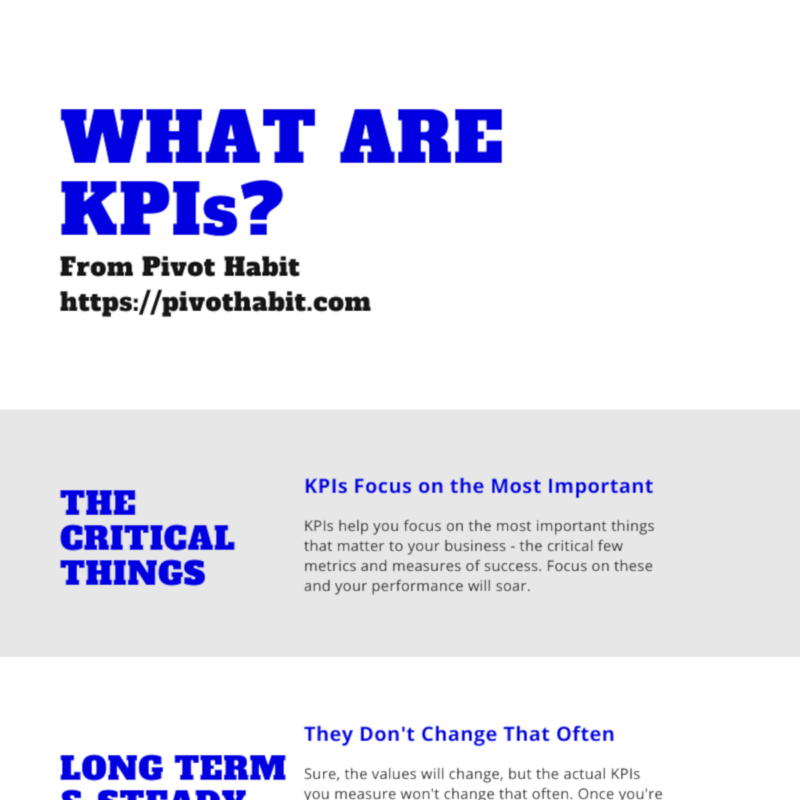KPIs, or Key Performance Indicators, are measures and metrics which we have identified as critically important and valuable for their ability to help us evaluate the performance of the business. Put another way, they are data points that instantly tell us either that some aspect of the business is performing well, or that some aspect of the business is having a problem. They provide us with a lot of information in a very short amount of time and help us keep on top of the business.
KPIs are one of the two professional management tools we use to aid command and control of the business. OKRs are the other.
What KPIs Do For the Business
Even if you’ve used Key Performance Indicators (KPIs) before, I want you to think of them as the “daily drivers” in your business. KPIs serve as the “early warning radar system” you need. I want you to be clear that their purpose is to:
 By their simple existence, they highlight those things which are important to measure in your business. I mean this in the vein of “What gets measured gets managed.” Also, “If you can’t measure it, you can’t managed it.” Both are quotes usually attributed to Peter Drucker.
By their simple existence, they highlight those things which are important to measure in your business. I mean this in the vein of “What gets measured gets managed.” Also, “If you can’t measure it, you can’t managed it.” Both are quotes usually attributed to Peter Drucker. KPIs are long term and steady. That is, we tend to keep the same KPIs quarter over quarter, and year over year. Obviously the values and even the targets change, but the KPIs we’re measuring and managing don’t change that frequently.
KPIs are long term and steady. That is, we tend to keep the same KPIs quarter over quarter, and year over year. Obviously the values and even the targets change, but the KPIs we’re measuring and managing don’t change that frequently. They provide “at a glance” intelligence about your business. When KPIs are crafted well and compiled effectively, you ought to be able to tell in 60 seconds or less which parts of your business are doing well and which aren’t. The clarity is amazing.
They provide “at a glance” intelligence about your business. When KPIs are crafted well and compiled effectively, you ought to be able to tell in 60 seconds or less which parts of your business are doing well and which aren’t. The clarity is amazing. They help drive performance and growth. That’s because we’re not going to simply record performance against KPIs. We’re going to establish baseline (where we are now) and target (where we want to be). Then we’ll plan out performance against our KPIs and measure our success along the way.
They help drive performance and growth. That’s because we’re not going to simply record performance against KPIs. We’re going to establish baseline (where we are now) and target (where we want to be). Then we’ll plan out performance against our KPIs and measure our success along the way. KPIs show the trend of your business. They highlight when things are getting better, holding steady, or declining. They show these things with plenty of time for you to be able to take action. That’s how they serve as an “early warning system.”
KPIs show the trend of your business. They highlight when things are getting better, holding steady, or declining. They show these things with plenty of time for you to be able to take action. That’s how they serve as an “early warning system.”
What It’s Like to Use Key Performance Indicators (KPIs)
Take literally no more than 10 seconds and look at the diagram below.

You should be able to immediately tell that:
- We’re making our revenue goals.
- Also, Cost of Goods must be under control because we’re making our Gross Profit Ratio.
- But Operating Profit is starting to dip.
- And we’re not making our NET Profit goals.
I don’t know about you but I feel like I have command of information. I know what questions to ask next to drill into the issues. And that was just using four data points. Normally, we’d have a more complete picture.
That is one of the key power points of KPIs, but there is much, much more.
Back to Index | Next Up: Measures and Metrics
![]()
Download the KPI Planning and Tracking Worksheet
Save hours of work by starting with a pre-made Excel Workbook featuring examples, explanations, and built-in calculations.


